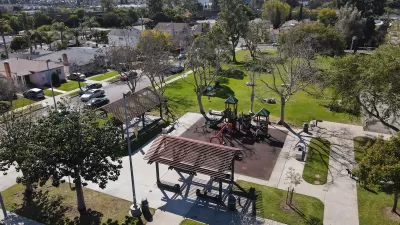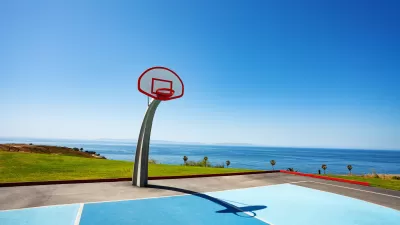Construction begins for a new pocket park in Westmont, an underserved unincorporated community in Los Angeles County.

Pocket parks may be small, but they are important in meeting the needs of urban communities that lack open space. Within Los Angeles County, the creation of such parks is a key strategy to improve park access and equity, enabling more residents to enjoy the multiple benefits that parks offer. As reported by Steven Sharp, construction has just begun on a new pocket park in the unincorporated community of Westmont, which has a very high level of park need per L.A. County's 2016 Countywide Parks Needs Assessment.
The park site was acquired by the L.A. County Department of Parks and Recreation (DPR) shortly after it was identified as a priority in the West Athens-Westmont Community Parks and Recreation Plan. In 2020, DPR successfully secured nearly $1.3 million in grant funds through California’s Proposition 68 Statewide Park Development Program to develop the park. The 0.16-acre pocket park will include a new play area with shade, therapeutic garden, space for rotating recreational activities, public art, storage shed and landscaping.
Transforming this overgrown and forgotten corner at a busy intersection into a lively and beautiful space for rest, play, socializing and exercise will positively impact the quality of life for Westmont residents. With the completion of this pocket park, the percentage of Westmont residents living within a 10-minute walk of a park would increase from 57 percent to 74 percent. This means that an additional 5,700 residents, including nearly 1,800 youths, would be able to walk to a nearby park.
FULL STORY: Construction begins for 95th & Normandie pocket park in Westmont

Manufactured Crisis: Losing the Nation’s Largest Source of Unsubsidized Affordable Housing
Manufactured housing communities have long been an affordable housing option for millions of people living in the U.S., but that affordability is disappearing rapidly. How did we get here?

Americans May Be Stuck — But Why?
Americans are moving a lot less than they once did, and that is a problem. While Yoni Applebaum, in his highly-publicized article Stuck, gets the reasons badly wrong, it's still important to ask: why are we moving so much less than before?

Using Old Oil and Gas Wells for Green Energy Storage
Penn State researchers have found that repurposing abandoned oil and gas wells for geothermal-assisted compressed-air energy storage can boost efficiency, reduce environmental risks, and support clean energy and job transitions.

Greening Oakland’s School Grounds
With help from community partners like the Trust for Public Land, Oakland Unified School District is turning barren, asphalt-covered schoolyards into vibrant, green spaces that support outdoor learning, play, and student well-being.

California Governor Suspends CEQA Reviews for Utilities in Fire Areas
Utility restoration efforts in areas affected by the January wildfires in Los Angeles will be exempt from environmental regulations to speed up the rebuilding of essential infrastructure.

Native American Communities Prepare to Lead on Environmental Stewardship
In the face of federal threats to public lands and conservation efforts, indigenous groups continue to model nature-centered conservation efforts.
Urban Design for Planners 1: Software Tools
This six-course series explores essential urban design concepts using open source software and equips planners with the tools they need to participate fully in the urban design process.
Planning for Universal Design
Learn the tools for implementing Universal Design in planning regulations.
Heyer Gruel & Associates PA
City of Moreno Valley
Institute for Housing and Urban Development Studies (IHS)
City of Grandview
Harvard GSD Executive Education
Salt Lake City
NYU Wagner Graduate School of Public Service
City of Cambridge, Maryland





























